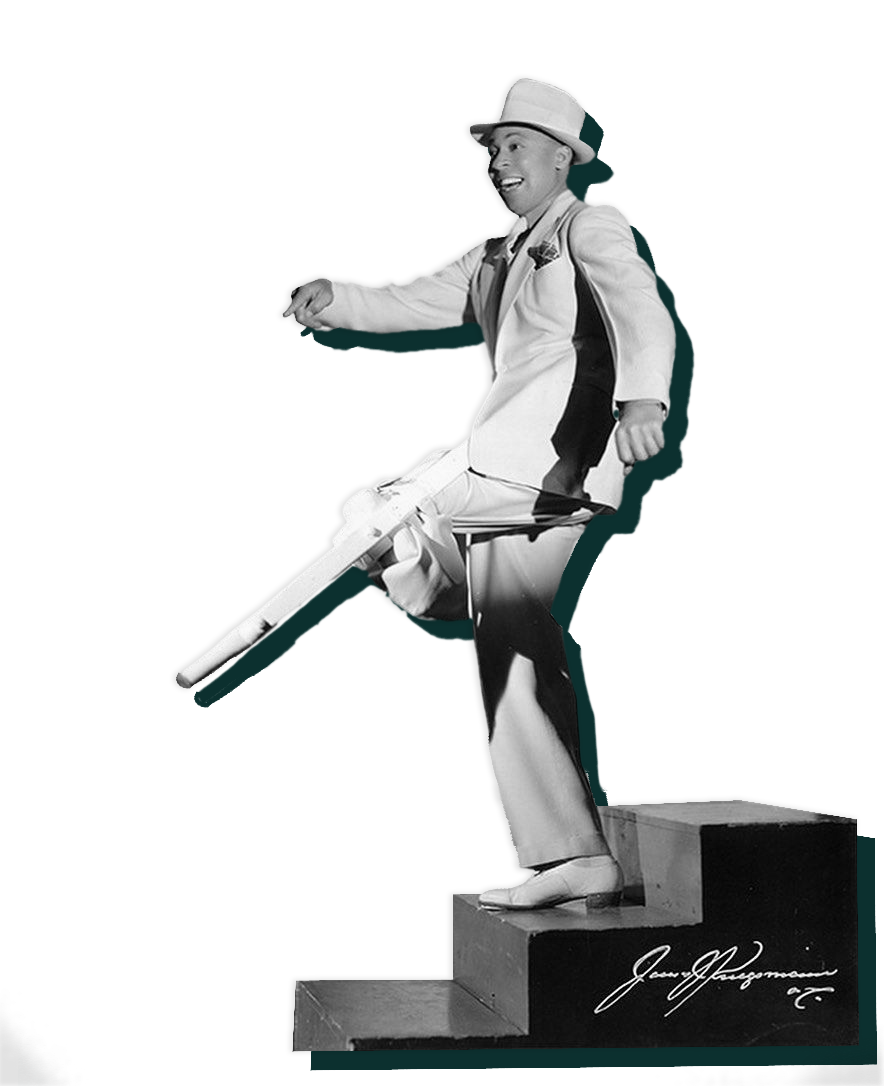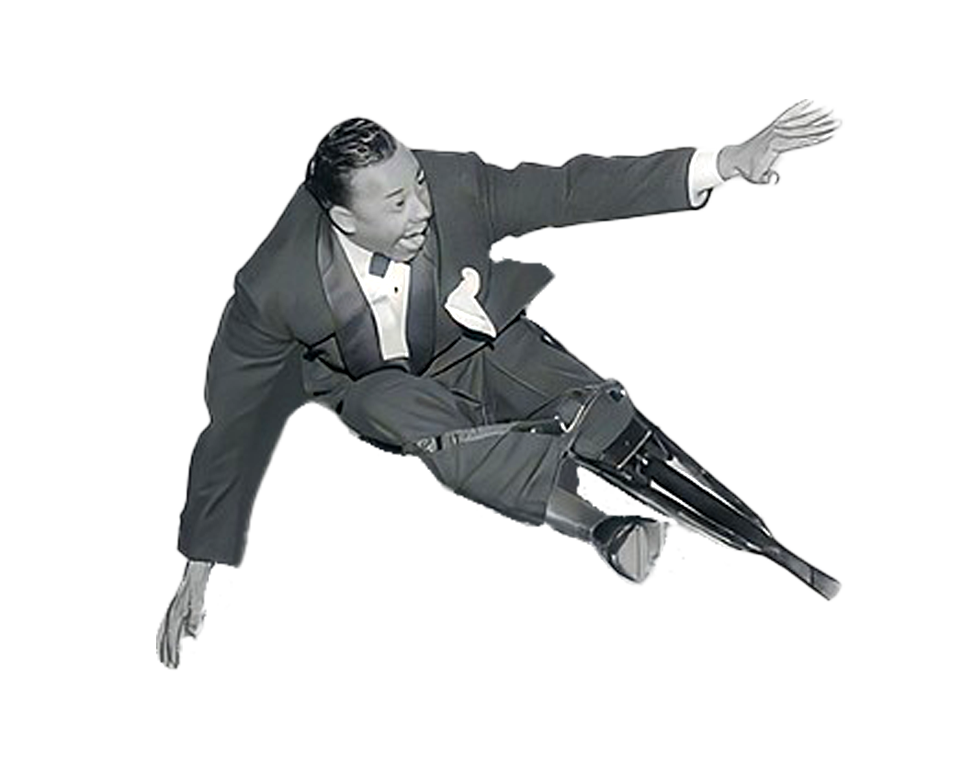The inspiring artist we highlight this year is Clayton ‘Peg Leg’ Bates. He is known as a great and famous tap dancer. Even with only one leg he was known as one of the greats among all tap dancers. This is his story.
Peg Leg Bates

The inspiring artist we highlight this year is Clayton ‘Peg Leg’ Bates. He is known as a great and famous tap dancer. Even with only one leg he was known as one of the greats among all tap dancers. This is his story:
Peg Leg Bates was born the 11th of October 1907 in Fountain Inn, South Carolina, a rural area. His mother was a sharecropper, meaning she rented land for part of the profit. His mom raised Peg Leg Bates by herself. Peg Leg Bates was born to be a dancer, as from the age of 5 he was already dancing on the streets for some pocket money.
At the young age of 12, while working at a cotton seed mill, Clayton Bates lost his leg in an accident with one of the machines.[1] While this definitely had a tremendous impact on his ability to move around and dance like he used to, he didn’t let the accident stop him from dancing. After his uncle came back from the war and fashioned him a peg leg, Clayton Bates was up again dancing.
“I was a dancer before I lost my leg and I still wanted to dance.” (The Dancing Man – Peg Leg Bates, Hudson West Productions)
Within 5 years, at the age of 20, Peg Leg Bates became a professional dancer performing on Broadway. But Peg Leg also performed in night-clubs, musicals, in films and on television, sometimes together with great known swing bands such as Duke Ellington and Count Basie.
To name all his great performances would be impossible, but to name a few:
- He performed at least 20 times on the Ed Sullivan show, a very famous television variety show. This is more times than any other performer.
- He performed twice for King George V and Queen Mary of England.
- He toured with Louis Armstrong.
“Well, I’m into rhythm and I’m into novelty. I’m into doing things that it looks almost impossible to do.” (Chicago Tribune, December 10th, 1998)
During the second world war, Peg Leg Bates toured war hospitals and camps. He found value in this, because he saw it as a way to give perspective to others who might be injured, disabled or greatly suffering.
“No point in waiting till a man is wounded to tell him he’s going to be okay”. (New yorker , nov 20 1943, p.19)


During this whole time Peg Leg Bates was met with a lot of racism and bad experiences like many other black performers. Segregation frustrated Peg Leg tremendously and in his own way he wanted to provide some type of safe haven for African Americans. In 1951, together with his wife, he opened a resort and club that was welcoming to all, called the Peg Leg Bates Interracial Country Club.[2] It became very well visited in the 1960s.
The Country Club stayed open till 1987, 2 years after his wife passed away. After her death, it got leased out. In the last years Peg Leg Bates saw the numbers of customers decreasing as segregation was banned and other resorts offered more luxury.
In his retirement Peg Leg Bates still kept performing to specific groups and inspiring them, such as youth groups until his death (6th of December 1998). He shared his message with them:
Clayton Peg Leg Bates never viewed the loss of his leg as something to pity or to let it stop him. In an interview in the New Yorker from 1943 he phrased it as the following:
“Now suppose I’d let that old leg get me down? I’d be walking down the streets today in shabby clothes and people would whisper, look at that poor old one-legged man. But I walk with my head high, and my hat on the side, and the diamond on my finger sparkles, and people turn around and say: Who is that one-legged man? Isn’t he sharp, Isn’t he something?”
Don’t look at me in sympathy,
I’m glad that I’m this way;
For I feel good and I’m knockin’ on wood…
As long as I could say.
I mix life’s fantastics up with hot gymnastics,
I’m Peg Leg Bates, the one-legged dancing man.
– Clayton “Peg Leg” Bates
(New Yorker , nov 20 1943, p.19)
References
[1] Different dates as to when he lost his leg appear in different sources
[2] other resource, the Independent, names 1960’s as the date, but this seems unlikely:
The following sources were used as research for this text:
- New yorker, November 20 1943, https://archives.newyorker.com/newyorker/1943-11-20/flipbook/018/
- The New York Times, July 15th 1985 https://www.nytimes.com/1985/07/15/nyregion/a-legend-and-his-catskills-resort-for-blacks.html
- The New York Times, December 8th 1998, https://www.nytimes.com/1998/12/08/arts/peg-leg-bates-one-legged-dancer-dies-at-91.html?searchResultPosition=1
- Wikipedia
- Metroconnects, february 7th 2023, https://www.metroconnects.org/peg-leg-bates/
- The Independent, December 11th 1998, https://www.independent.co.uk/arts-entertainment/obituary-peg-leg-bates-1190580.html
- Tales from the Hearth, February 28th, 2020, https://alishactaylor.com/peglegbates/’
- Chicago Tribune, December 10th, 1998 https://www.chicagotribune.com/news/ct-xpm-1998-12-10-9812100141-story.html

